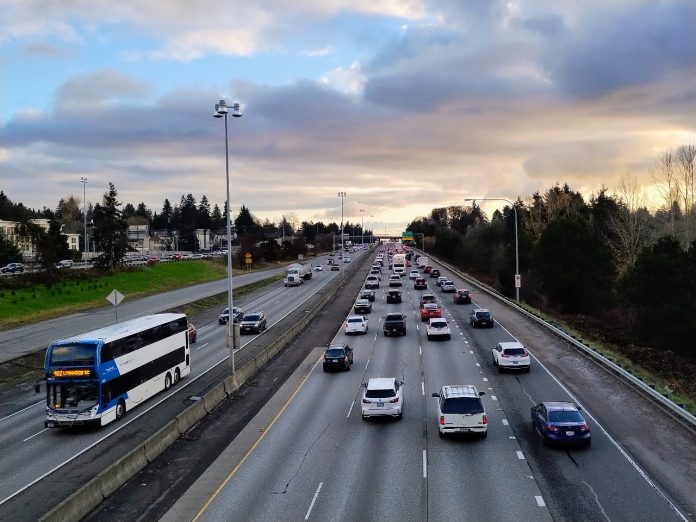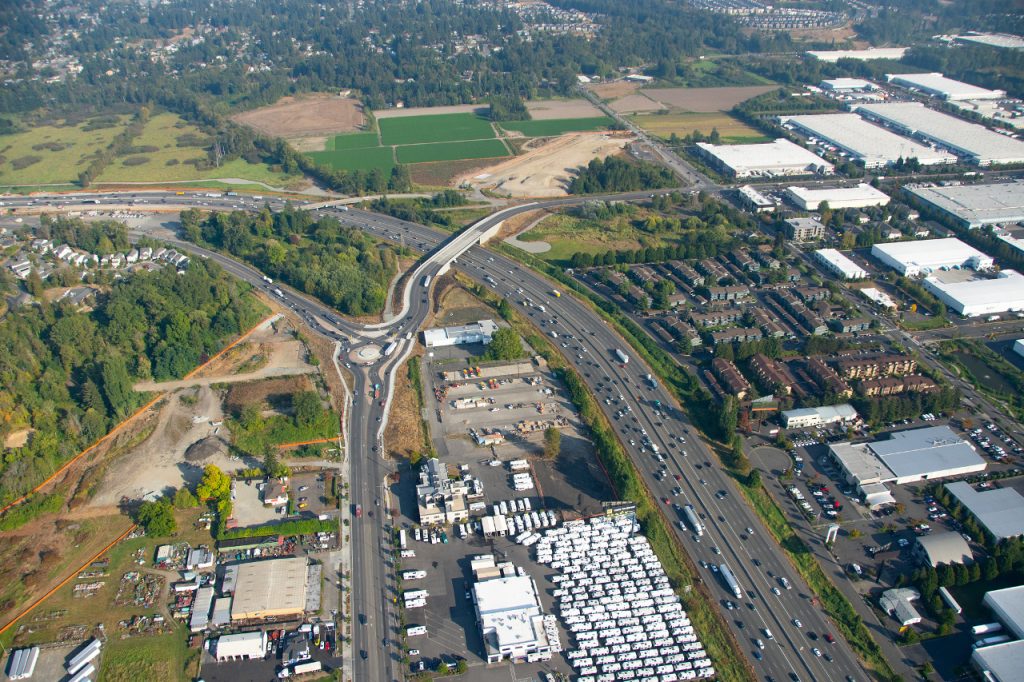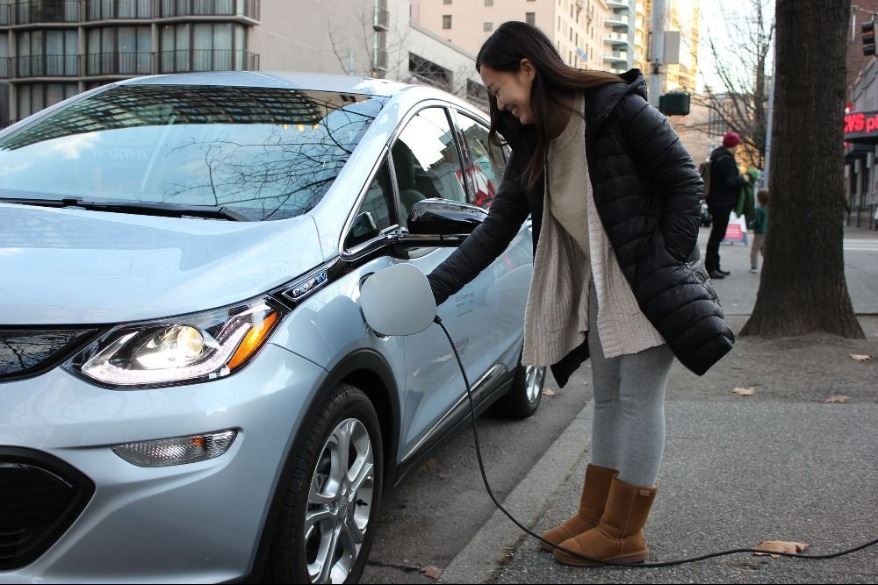
A small change around regional grant funding criteria could prove a bellwether for transportation policy in Puget Sound.
Everywhere from Lynnwood to Puyallup, from Auburn to Silverdale, the long-range transportation plan for central Puget Sound calls for a significant expansion of the region’s roadways over the coming decades, even as evidence mounts that expanding roads to accommodate more general purpose traffic just leads to more traffic and more pollution, while rarely achieving the stated aim of decreasing travel times, improving mobility, or keeping freight moving. But a debate happening at the Puget Sound Regional Council (PSRC), the organization tasked with regional planning for King, Pierce, Snohomish, and Kitsap Counties, signals that there is some appetite to shift away from the business-as-usual approach.
The debate centers around the way that PSRC leaders (though a board composed of local elected officials) selects transportation projects to be funded via the region’s share of grant funding from the Federal Highway Administration (FHWA). Every two years, local governments put in grant applications asking for dollars for specific projects intended to improve their transportation systems, but before that happens, there’s is an opportunity for those elected officials to reassess the criteria for selecting those projects, to help achieve regional goals and align transportation spending with PSRC’s regional growth strategy.
Two years ago, The Urbanist covered the last shakeup in that project selection process, in which PSRC approved a new specific set-aside for transportation projects that are targeted toward improving equity, but declined to approve an increase in the existing set-aside for projects specifically aimed at improving safety for people walking, biking, and rolling. But they did approve the pulling out of safety as its own specific category for projects to be graded on. Ultimately, the majority of electeds leading PSRC at that time wanted to see small tweaks to the prioritization process, but not significant changes.
Now, PSRC is again considering proposals to revamp the selection criteria for its 2024 funding round, with final decisions set to be made early next year. And in line with the officially adopted Regional Transportation Plan’s focus on Washington’s 2030 climate goals, some regional leaders have put forward the question of whether projects that add general-purpose capacity to the region’s roadways should be eligible to compete in the first place.
“If we’re that serious about climate, are we really going to put dollars into projects that are demonstrated to increase vehicle miles traveled and increase greenhouse gas?” is how Pierce County Councilmember Ryan Mello, vice-chair of PSRC’s Transportation Policy Board, framed the question when this idea was first put on the table in November.
The question isn’t a theoretical one. In 2022, PSRC awarded $5.4 million dollars in FHWA funds to the final phase of the Washington State Department of Transportation’s megaproject extending State Route 167 between Puyallup and Tacoma, beating out projects like Sound Transit’s infill light rail station at Graham Street in Seattle and pedestrian/bicycle improvements to California Street in Everett. The SR 167 project is a state priority due to potential benefits that will come to freight mobility from its completion, connecting the Port of Tacoma more directly with I-5, but the project almost certainly won’t push the region in the right direction when it comes to the established goals around reducing overall passenger vehicle traffic and emissions.

Elsewhere in the country, state and local governments are starting to reassess whether it makes sense to invest their scarce transportation dollars into expanding roadways. Last year, the state of Colorado declined to move forward with adding lanes to I-25 and Colorado State Route 470, both of which serve the Denver metro area, following a transportation funding package that the Colorado legislature passed in 2021 that also includes more climate-focused transportation planning in the state.
Under the bill, Colorado’s Department of Transportation and the Colorado equivalents to PSRC are required to undertake an “enhanced level of planning” to account for potential induced demand, the idea that roadway capacity projects will increase usage for those facilities all on its own by making travel easier. Following the bill’s adoption, Colorado enacted new goals around greenhouse gas emissions and vehicle miles traveled, and transportation projects have to fit within those “budgets,” with an expected impact on statewide VMT as high as 9%.
Washington isn’t yet being held to Colorado’s standard, with the proposal at PSRC to simply prioritize other projects for a small pot of FHWA funding much less broad. Yet the idea has received a fair amount of pushback from some regional elected officials who argue that increased electrification of vehicles will still allow the region to expand roadways without impacting climate goals, and that local governments should have the flexibility to be able to add new roads to help achieve regional goals.
“In a beautifully functioning system, climate pollution from transportation will not be a criteria in ten or fifteen years, because we’re supposed to be going mostly electric, and using clean fuels.” Kitsap County Commissioner Christine Rolfes said at that November meeting. “So from a transportation perspective, that will probably lose its emphasis in time but congestion and safety are going to stay … that’s always going to be a problem.”
Currently, around 2% of the total number of passenger vehicles registered in Washington are electric, and the state has seen a steady increase in the sale of EVs, with 18% of new cars sold in Washington during the first six months of 2023 being electric. But fossil fuel vehicles won’t begin to be fully phased out in Washington until 2035 according to today’s timelines, meaning the beautifully functioning system that Rolfes is referring to is quite a long ways off if it’s ever arriving.

“My concern with using the thought that new capacity is going to increase vehicle miles traveled and greenhouse gases is concerning, because in my town, a suburban with superblocks, the way for us to get the density and to get greener, is to create streets where parking lots were,” Issaquah Mayor Mary Lou Pauly said. “Some people will argue that’s increased capacity, and I will push back that, depending on the type of vehicles that are moving around, if it’s more buses, and if it’s electric buses, it’s not more greenhouse gases.”
Pauly’s use of superblock calls to mind suburban big-box stores but also innovative approaches to transportation being implemented in places like Barcelona, which have used bollards and car diverters to create a groups of city blocks where walking, biking, and rolling are the predominate mode. Cities like Issaquah that want to break up their largest blocks don’t necessarily have to do so by creating a net addition of vehicle space, and by doing so might actually be undermining their own transportation goals.
Bellevue councilmember Jennifer Robertson, set to leave public office at the end of this year, backed up Pauly’s position.
“If you want to have TOD [transit-oriented development] around light rail stations, you got to have places for people to walk, and bike, and get into their buildings … and buses to connect,” Robertson said. “So you’re going to have more streets. That capacity can be climate-friendly in that it allows the TOD to develop. You’re more likely to have complete streets with places for bicyclists and pedestrians to walk, places for buses to drive.”
Robertson asserted that a move toward creating more complete streets in Washington will require right-of-way acquisition, rather than reallocating existing street space.
By December, the proposal had been solidified and also scaled back, seemingly in response to concerns from members like Pauly and Robertson: Projects adding general purpose capacity to limited-access highways throughout central Puget Sound wouldn’t be able to compete. Projects expanding roadways to add general purpose capacity, even to state highways, would still be allowed to compete if they weren’t dealing with grade separated highways like SR 167, I-405, or I-5.
Yet there were concerns raised about the latest version of the proposal, by the same officials. Pauly cited a concern about process, that the body hadn’t had enough time to consider the idea, and that they didn’t know what the ramifications could be.
“We’re asking this body to consider something of significant impact, with kind of an abbreviated conversation,” Pauly said. “I don’t know, of all of the examples of where there may be a possibility that this ‘do not allow’ clause will then end up doing damage to the greater elements of Vision 2050 and being able to make those greenhouse gas reductions in the way that we need to, which is really in how we use our land.”
Recent WSDOT reports to the state legislature on how to reduce VMTs have emphasized the role of land use, but also underlined how highway expansion undercuts constructive land use decisions. An analysis conducted jointly by WSDOT and the Thurston Regional Planning Council found that adding an additional general purpose lane to I-5 through Thurston County would have the effect of reversing 20 years of transit-focused land use planning there.
At that December meeting, proponents of this change stood their ground. “I don’t think this concept is new,” Mello said, staying the most outspoken proponent of the idea. “I think it’s very consistent with what we’ve been talking about with our climate goals … We’ve been talking for a long time about reducing vehicle miles traveled, and that is not a new concept.”
Mello was joined in outspoken support for the proposal by Tacoma City Councilmember Kristina Walker, and also indirectly by Kirkland Deputy Mayor Jay Arnold, who asked PSRC to look at broader language in scoring criteria for projects that rewards congestion relief.
Both Mello and Walker made the argument that the dollars that are set to be awarded next year won’t be actually allocated until 2027 or 2028, so PSRC has to be forward-thinking about how the funding will be used. Seattle, which has some of the most ambitious goals for reducing VMT compared to other regional cities, hasn’t had a voice in this broader discussion as Councilmembers Alex Pedersen and Dan Strauss, either weren’t present or didn’t chime in during discussions.
At the regional level, broad goals are easy to support but proposals to fundamentally shift the way funding gets distributed are generally treated much less favorably. Ultimately, if the idea moves forward early next year, it won’t be a seismic shift in and of itself. But it would signal that the region is ready to start looking critically at whether its transportation investments are aligned with its lofty ideals around climate change, or whether it’s fine with the status quo.
Ryan Packer has been writing for The Urbanist since 2015, and currently reports full-time as Contributing Editor. Their beats are transportation, land use, public space, traffic safety, and obscure community meetings. Packer has also reported for other regional outlets including BikePortland, Seattle Met, and PubliCola. They live in the Capitol Hill neighborhood of Seattle.

